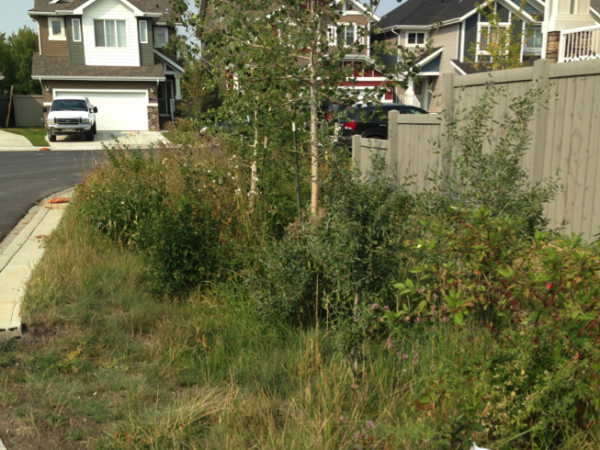The conditions of a Canadian winter can be harsh and unforgiving for wild animals. Some, like many bird species, just avoid it completely. Others, like bears and ground squirrels who aren’t able to fly to warmer climates, have adapted the ability to hibernate, essentially sleeping through winter as a strategy for surviving it. Deer and other wild ungulates (hoofed mammals) have adapted a different strategy. Ungulates take on winter by budgeting their energy — a meticulous balance of daily expenditure that gives them the best chance of surviving a long winter with very limited food.

The first part of a mule deer’s (or any wild northern ungulate’s) energy budgeting strategy is to put some savings away for a rainy (or snowy) day. Budgeting energy begins during the summer months and extends into the autumn as ungulates fatten up on the abundant forage of summertime. Food will be much harder to come by in the winter, and these fat stores allow deer to survive on poorer nutrition as food becomes less and less available, with each bite providing fewer and fewer calories.

The second aspect of an ungulate’s winter energy budget is a tenuous tug-of-war between the energy an individual takes in, versus the energy it uses and looses on a daily basis. Ungulates travel far less in the winter to conserve energy, especially because moving through deep snow expends far more energy than walking on flat terrain. This means that ungulates have to choose a winter habitat that suits their needs without requiring them to travel too far. Body temperature and heart rate also play a role in energy expenditure. For example, a study in elk (Cervus canadensis) found that more dominant, active females tend to lose more body mass because they have higher average body temperatures and heart rates than subordinate females (Turbill et al., 2013). The behaviour of moderating energy expenditure is an interesting behaviour that helps ungulates weather the long Canadian winters, but it is also a gamble that doesn’t always pay off.

The energy tightrope that northern ungulates navigate during winter can become a lot more wobbly when people get involved. Human activities, especially those that include the use of motorized vehicles such as snowmobiles, can force animals like mule deer and other ungulates to move more than their energy budget allows. Motorized vehicles can disrupt large areas of habitat in a short amount of time, and studies have shown that moose (Alces alces) within 150 meters of a snowmobile trail are likely to change their behaviour from what would be expected in areas without snowmobile trails (Colescott & Gillingham 1998). Mountain caribou populations in particular are believed to be impacted by human winter recreation activities, avoiding high quality habitat when there is a chance of encountering a snowmobile (Seip, Johnson & Watts 2010) The more an ungulate has to move unnecessarily in the winter, and the farther it has to travel to find habitats where it wont be disturbed, the more likely it is to use up its fat stores before winter has ended, resulting in mortality.

In short, the life of an ungulate is tough, especially in the winter when their best chance at survival is to strictly adhere to a stingy calorie budget. Understanding the unique ways that animals cope with their environment gives us insights into their life requirements and can help us to understand more about how our actions can impact them.
Weathering the Storm was researched and written by Bria Griffin.
Literature
Colescott, J. H., and M. P. Gillingham. 1998. View of Reaction of Moose (Alces Alces) to Snowmobile Traffic in the Greys River Valley, Wyoming, ALCES VOL. 34(2): 329-338 alcesjournal.org/index.php/alces/article/view/755/837.
Harris, G., R. M. Nielson, T. Rinaldi, and T. Lohuis. 2014. Effects of Winter Recreation on Northern Ungulates with Focus on Moose (Alces Alces) and Snowmobiles – European Journal of Wildlife Research, 60: 45-58, https://doi.org/10.1007/s10344-013-0749-0.
Seip, D. R., C. J. Johnson, and G. S. Watts. 2010. Displacement of Mountain Caribou from Winter Habitat by Snowmobiles. Journal of Wildlife Management, 79(5): 1539-1544, https://doi.org/10.2193/2006-387
Simpson, K., and E. Terry. 2000. Impacts of Backcountry Recreation Activities on Mountain Caribou — Management Concerns, Interim management Guidelines and Research Needs. BC Minst. Environ., Lands and Parks, Wildl. Branch, Victoria, BC. Wildl. Working Rep. No. WR-99. 11pp. Available online at: http://bcnorth.ca/caribou/Impacts-Backcountry-recreation-Activities-Mountain-Caribou_2000.pdf
Turbill, C., T. Ruf, A. Rothmann, and W. Arnold. 2013. Social dominance is associated with individual differences in heart rate and energetic response to food restriction in female Red Deer. Physiological and Biochemical Zoology, vol. 86(5): 528–537, https://doi.org/10.1086/672372.





